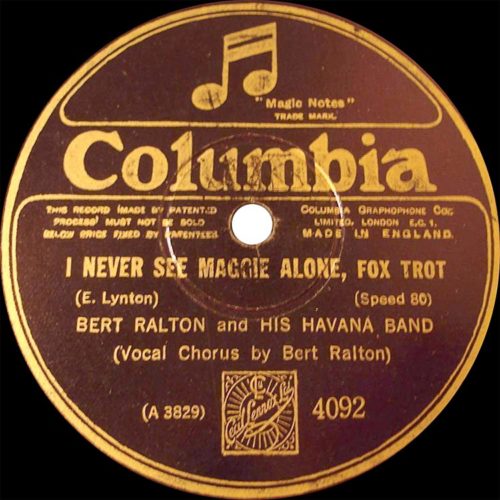“I Never See Maggie Alone”
Song by Ray Charles
The comical tune “I Never See Maggie Alone” was covered by Ray Charles on his 1964 album Have A Smile With Me. Whereas the song’s first release, in 1926 by Bert Ralton and His Havana Band, was done in a fox trot, it was Kenny Roberts’ charming 1949 country version that brought the tune to renewed popularity.
Ray Charles does the song in his own style: he slows the pace down by about half, and the arrangement by Johnny Parker adds blasts of brass and a swinging, modern jazz feel.
Who wrote “I Never See Maggie Alone”?
There seem to be three different credits given for the authorship of “I Never See Maggie Alone” on various artists’ record labels. Sometimes it is credited to Everett Lynton; sometimes to Everett Lynton and Henry Tilsley; and sometimes to Henry Tilsley and Lawrence Wright.
The truth is that the song was written by Tilsley and Wright, and that Wright often used aliases, “Everett Lynton” being one of them. On the Ray Charles vinyl record label, the song’s credits are Tilsley and Lynton. Close enough.

Singer Bert Ralton first released “I Never See Maggie Alone” in 1926.
The song
The lyrics to “I Never See Maggie Alone” are a comical lament by a guy whose date, Maggie, always brings several members of her large family with her when they get together; he’s aggrieved and dismayed by the long list of relatives that show up everywhere. No matter where he and the girl go, her siblings, parents, and cousins (“you know, she’s got ’em by the dozen”) are there.
Ray’s version begins slowly, his taut and tense band playing slowly and sorrowfully behind him while he sobs the opening words with an emotional gravity that seems out of proportion to the heretofore silly tune. In short, despite the intended “lighthearted novelty” feel of Have A Smile With Me, Ray drenches “I Never See Maggie Alone” in his usual mid-1960s feeling of heroin-tinged exhaustion.
Which is not to say that Ray is unaware of or unwilling to indulge in the comedy of the song: he complains about the constant frustration of his situation as the song requires. It’s just that there is a seriousness throughout “I Never See Maggie Alone” that doesn’t quite match its goofy sentiments.
The music is great, of course; the punchy brass blasts and Ray’s accompanying piano are delightful, and pull the focus away from the lyrics and towards Ray and his complicated musical genius.
Listen to “I Never See Maggie Alone”
Get your own “I Never See Maggie Alone” on LP, CD or MP3 from Amazon.

Like to see chords and lyrics done by bluegrass band